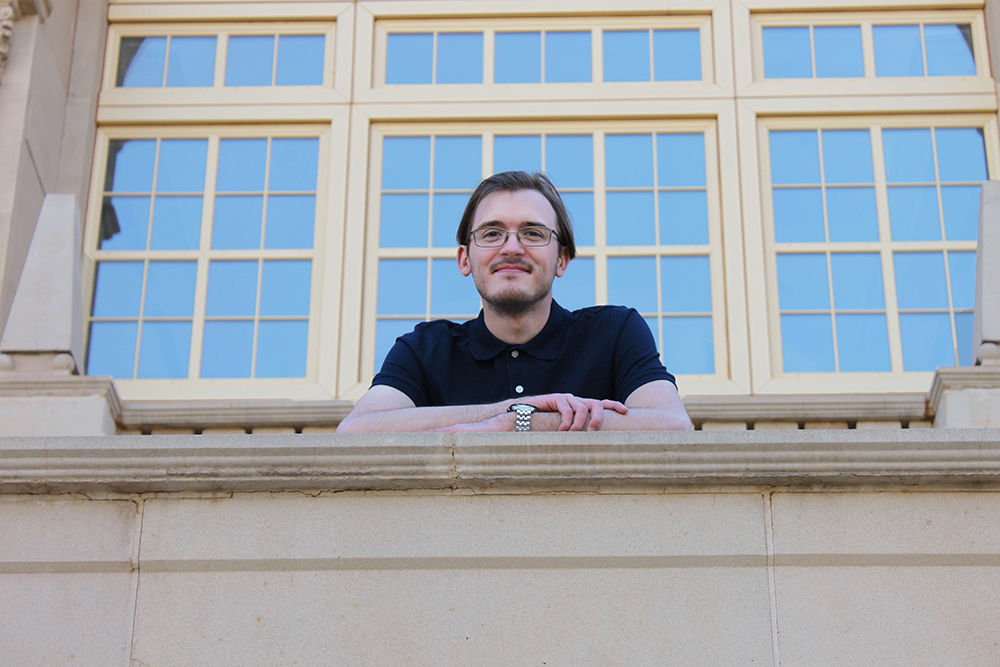
Nicholas Clark Is on an Upward Trajectory
Geosciences Graduate Student Publishes 3 Research Papers from His Undergraduate Days
6.8.2022 | Toni Salama
While Nicholas Clark was working toward his bachelor's degree at Texas Tech University, he spent more than two-and-a-half years conducting undergraduate research in the lab of his faculty mentor, atmospheric scientist Sandip Pal.
Between 2019 and 2021, Clark flourished as a budding scientist, taking a significant part in three research projects that yielded findings worthy of publication. The papers were submitted to three different scientific journals.
And the wait began.
But Clark did more than wait. He completed his bachelor's in mathematics and minor in atmospheric science in the spring of 2021 and entered TTU's Graduate School the following summer to pursue an advanced degree in atmospheric science in the Department of Geosciences.
It was Clark's platform for an upward trajectory.
Now, as a graduate teaching assistant, Clark conducts some of the undergraduate classes where he himself was so recently a student. He continues his research as a member of the Boundary Layer Meteorology Group. In April 2022, he started a three-year term as a student member of the American Meteorological Society's Committee for Measurements.
And the waiting paid off.
“He just received the acceptance letter of his first paper, as first author, from the editorial office of the American Meteorological Society,” said Pal, who leads the Boundary Layer Meteorology Group in the College of Arts & Sciences' Department of Geosciences.
“Beginning research during my undergrad years was absolutely game-changing in terms of my success as an academic and future atmospheric scientist,” Clark said. “When I first started my undergraduate research career, I definitely didn't think my work would amount to anything publish-worthy. I simply performed the necessary analyses and wrote about them until it eventually got to a point where the results spoke for themselves.”
With that much of the work done, his research then became a matter of storytelling: of curating a story from beginning to end, of describing how the results came about and how they fit into the larger research literature.
“More or less, this is what research is about,” Clark said, “and it was an amazing opportunity getting to learn about this at such a crucial part of my academic career.”
Pal explained that publishing research papers in highly respected journals takes time because of the associated peer-review process.
Two of Clark's other undergrad research papers, on which he served as second author and third author, had published previously.
“Now, finally, he has seen all his undergraduate research work published,” Pal said of Clark's efforts.
But publication alone doesn't tell the whole story of a research project's influence. Once published, the findings must be valuable enough for other scientists to cite in their own work. One way to quantify that influence is to consult an index called the impact factor.
Pal described the impact factor, or IF, this way:
“The IF of an academic journal is a scientometric index, calculated by Clarivate, that reflects the yearly total number of citations of articles published during the last two years in any given journal. The impact factor is used as a proxy for the relative importance of a journal within its field,” Pal said. “The higher the impact factor, the higher the importance and prestige, and vice versa.”
Except for publications with mass appeal, such as Science and Nature, most topical journals in the field of atmospheric science carry an impact factor from 2 to 5, Pal said.
Clark's published work, backed up by solid IF figures, is a testament to the value of the College of Arts & Sciences' undergraduate research programs in putting tomorrow's scientists on a lifelong road of meaningful discovery:
-
- Clark was first author on the project, “Empirical evidence for frontal modifications of atmospheric boundary layer depth variability over land,” accepted for publication in the Journal of Applied Meteorology and Climatology. (Impact Factor of 2.9)
- Clark was second author on the project, “When and where horizontal advection is critical to alter the atmospheric boundary layer features over land: Need for a conceptual framework,” accepted for publication in Elsevier's Atmospheric Research. (Impact Factor of 5.4)
- Clark was third author on the project, “Mississippi and Missouri River Flooding and Its Impact on Atmospheric Boundary Layer Dynamics,” accepted for publication in the American Geophysical Union's Geophysical Research Letters. (Impact Factor of 4.50)
Clark compared his undergraduate research projects to stepping stones, learning valuable lessons from each that he uses in his graduate research today.
“The hardships and successes of my past projects allow me to get work done in record time with a more complete understanding than ever before,” he said. “Overall, I know my current work and future projects will no doubt be better with each passing stone, and I look forward to doing this for a long time as a result.”
College of Arts & Sciences
-
Address
Texas Tech University, Box 41034, Lubbock, TX 79409-1034 -
Phone
806.742.3831 -
Email
arts-and-sciences@ttu.edu
